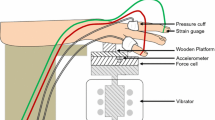Abstract
To investigate whether the Pacinian channel is involved in vibration-induced reductions of finger blood flow (FBF), vibrotactile thresholds and vasoconstriction have been studied with 125-Hz vibration and two contact areas: 3- or 6-mm-diameter vibrating probes with 2-mm gaps to fixed surrounds. Fifteen subjects provided thresholds for perceiving vibration at the thenar eminence of the right hand with both contact areas. With both contact areas, FBF was then measured in the middle fingers of both hands during five successive 5-min periods: (i) no force and no vibration, (ii) force and no vibration, (iii) force with vibration 15 dB above threshold, (iv) force and no vibration, and (v) no force and no vibration. Thresholds were in the ranges of 0.16–0.66 ms−2 r.m.s. (6-mm probe) and 0.32–1.62 ms−2 r.m.s. (3-mm probe). With the magnitude of vibration 15 dB above each individual’s threshold with the 3-mm probe, the median reduction in FBF with the 6-mm probe (to 70 and 77 % of pre-exposure FBF on the exposed right hand and the unexposed left hand, respectively) was greater than with the 3-mm probe (79 and 85 %). There were similar reductions in FBF when vibration was presented by the two contactors at the same sensation level (i.e. 15 dB above threshold with each probe). The findings are consistent with reductions in FBF arising from excitation of the Pacinian channel: increasing the area excited by vibration increases Pacinian activation and provokes stronger perception of vibration and greater vasoconstriction.




Similar content being viewed by others
References
Bolanowski SJ, Gescheider GA, Verrillo RT, Checkosky CM (1988) Four channels mediate the mechanical aspects of touch. J Acoust Soc Am 84:1680–1694
Bovenzi M (1989) Cardiovascular responses to autonomic stimulation in vibration-induced white finger. Eur J Appl Physiol 59:199–208
Bovenzi M, Griffin MJ, Ruffell CM (1995) Acute effects of vibration on digital circulatory function in healthy men. Occup Environ Med 52:834–841
Bovenzi M, Lindsell CJ, Griffin MJ (1998) Duration of acute exposure to vibration and finger circulation. Scand J Work Environ Health 24(2):130–137
Bovenzi M, Lindsell CJ, Griffin MJ (1999) Magnitude of acute exposure to vibration and finger circulation. Scand J Work Environ Health 25(3):278–284
Bovenzi M, Lindsell CJ, Griffin MJ (2000) Acute vascular responses to the frequency of vibration transmitted to the hand. Occup Environ Med 57:422–430
Bovenzi M, Welsh AJL, Griffin MJ (2004) Acute effects of continuous and intermittent vibration on finger circulation. Int Arch Occup Environ Health 77:255–263
Bovenzi M, Welsh AJL, Vedova AD, Griffin MJ (2006) Acute effects of force and vibration on FBF. Occup Environ Med 63:84–91
Capraro AJ, Verrillo RT, Zwislocki JJ (1979) Psychophysical evidence for a triplex system of mechanoreception. Sens Process 3:334–352
Gemne G (1994) Diagnostics of hand-arm system disorders in workers who use vibrating tools. Occup Environ Med 54:90–95
Gemne G, Pyykko I, Taylor W, Pelmear PL (1987) The Stockholm Workshop scale for the classification of cold-induced Raynaud’s phenomenon in the hand-arm vibration syndrome (revision of the Taylor–Pelmear scale). Scand J Work Environ Health 13(4):275–278
Greenfield ADM, Whitney RJ, Mowbray JF (1963) Methods for the investigation of peripheral blood flow. Br Med Bull 19:101–109
Griffin MJ (1990) Handbook of human vibration. Academic Press, London
Griffin MJ, Bovenzi M (2002) The diagnosis of disorders caused by hand-transmitted vibration: Southampton workshop 2000. Int Arch Occup and Environ Health 75(1–2):1–5
Griffin MJ, Welsh AJL, Bovenzi M (2006) Acute response of finger circulation to force and vibration applied at the palm of the hand. Scand J Work Environ Health 32(5):383–391
Harada N, Griffin MJ (1991) Factors influencing vibration sense thresholds used to assess occupational exposures to hand transmitted vibration. Br J Ind Med 48:185–192
International Organization for Standardization (2001) Mechanical vibration—measurement and evaluation of human exposure to hand-transmitted vibration—part 1: general requirements. International standard, ISO 5349-1. ISO, Geneva
Lindsell CJ (1997) Vibrotactile thresholds: effect of contact forces and skin indentation. Presented at the UK group meeting on human response to vibration, Human Factors Research Unit, Southampton, 17–19 September 1997
Morioka M, Griffin MJ (2005) Thresholds for the perception of hand-transmitted vibration: dependence on contact area and contact location. Somatosens Mot Res 22:281–297
Morioka M, Whitehouse DJ, Griffin MJ (2008) Vibrotactile thresholds at the fingertip, volar forearm, large toe, and heel. Somatosens Mot Res 25:101–112
Olsen N, Petring OU, Rossing N (1987) Exaggerated postural vasoconstrictor reflex in Raynaud’s phenomenon. British Med J 294:1186–1188
Takeuchi T, Futatsuka M, Imanishi H, Yamada S (1986) Pathological changes observed in the finger biopsy of patients with vibration-induced white finger. Scan J Work Environ Health 12:280–283
Thompson AJL, Griffin MJ (2009) Effect of the magnitude and frequency of hand-transmitted vibration on finger blood flow during and after exposure to vibration. Int Arch Occup Environ Health 82:1151–1162
Verrillo RT (1962) Investigation of some parameters of the cutaneous threshold for vibration. J Acoust Soc Am 34:1768–1773
Verrillo RT (1963) Effect of contact area on the vibrotactile threshold. J Acoust Soc Am 35:1962–1971
Verrillo RT (1968) A duplex mechanism of mechanoreception. In: Kenshalo DR (ed) The skin senses. CC Thomas, Springfield
Verrillo RT, Bolanowski SJ, Gescheider GA (2002) Effect of aging on the subjective magnitude of vibration. Somatosens Mot Res 19:238–244
Ye Y, Griffin MJ (2011) Reductions in finger blood flow in men and women induced by 125-Hz vibration: association with vibration perception thresholds. J Appl Physol 111:1606–1613
Conflict of interest
The authors declare that they have no conflict of interest.
Author information
Authors and Affiliations
Corresponding author
Additional information
Communicated by Massimo Pagani.
Rights and permissions
About this article
Cite this article
Ye, Y., Griffin, M.J. Reductions in finger blood flow induced by 125-Hz vibration: effect of area of contact with vibration. Eur J Appl Physiol 113, 1017–1026 (2013). https://doi.org/10.1007/s00421-012-2518-2
Received:
Accepted:
Published:
Issue Date:
DOI: https://doi.org/10.1007/s00421-012-2518-2




